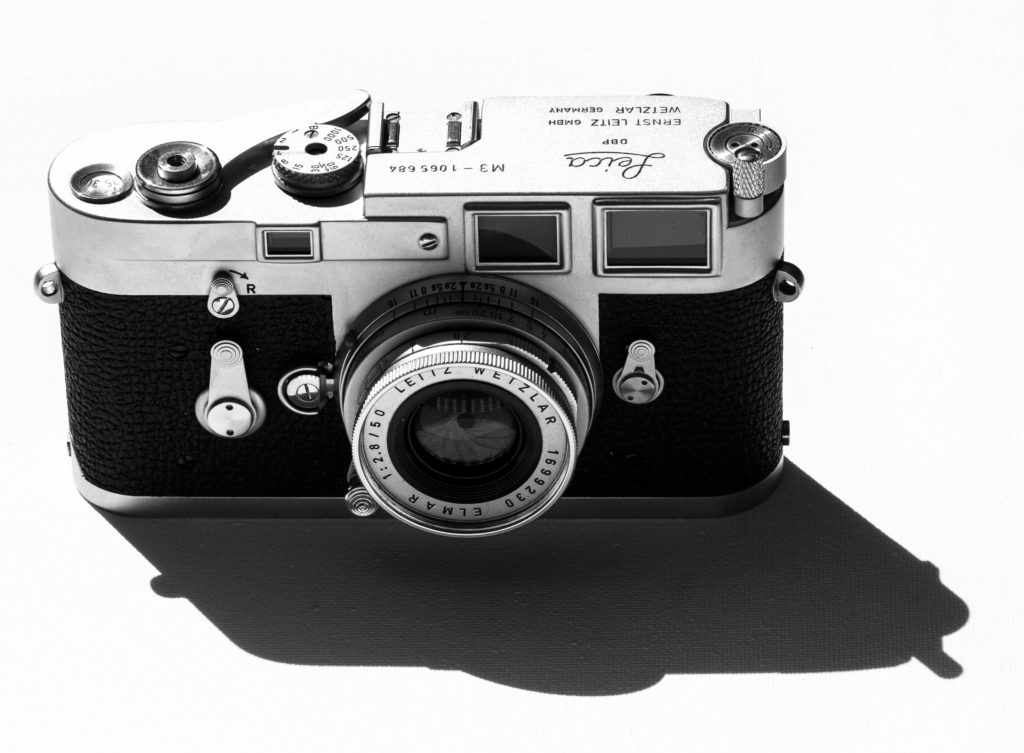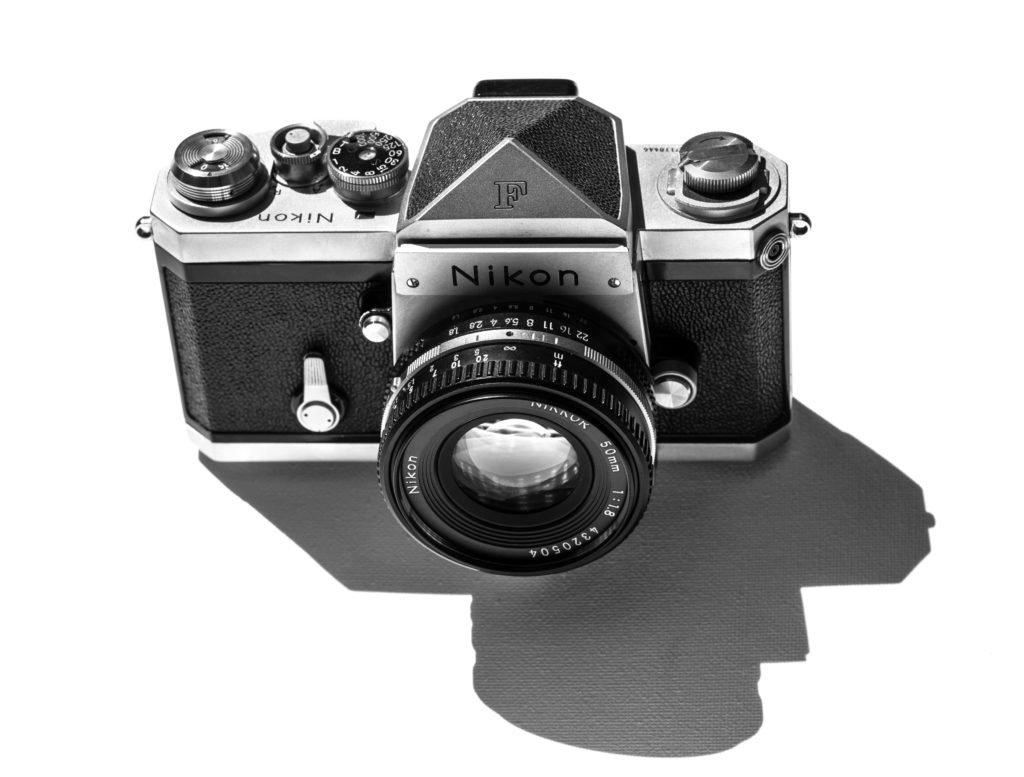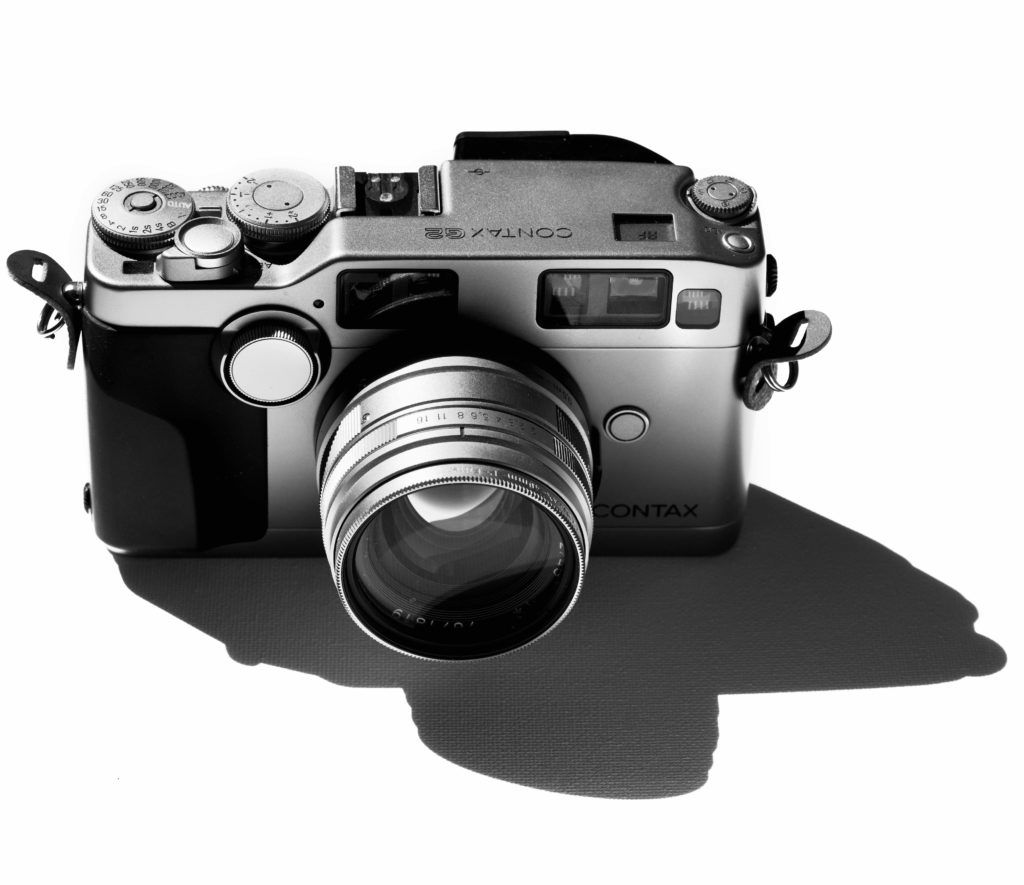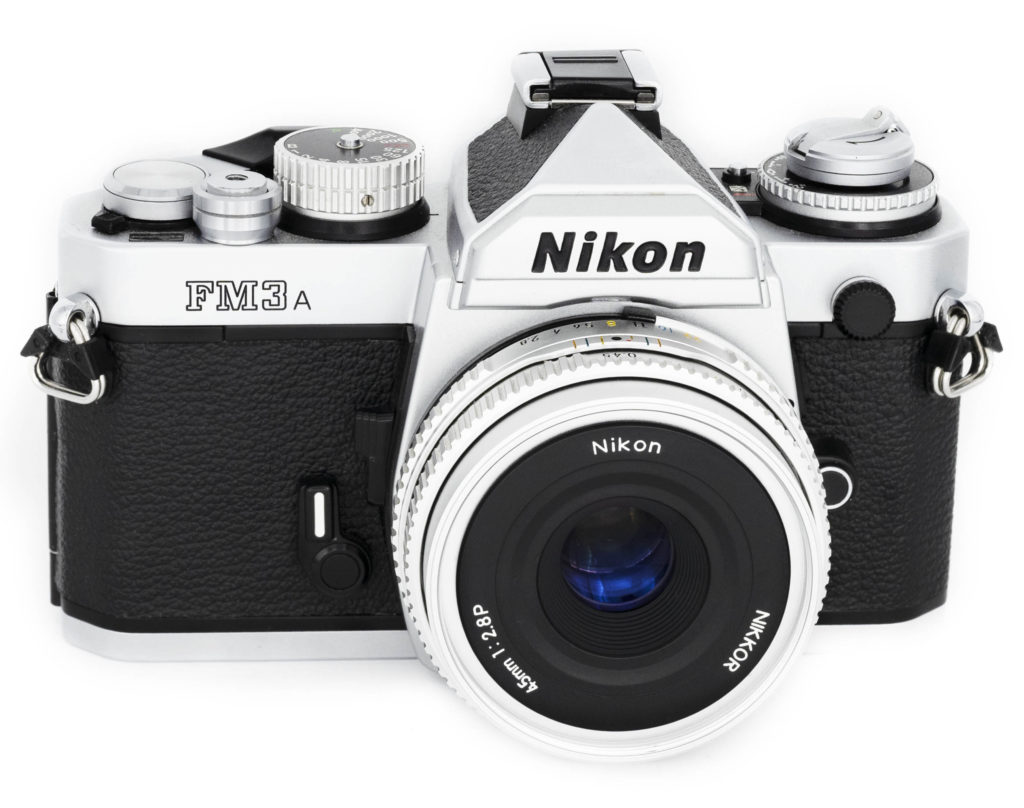This timeline of early cameras describes significant photographic milestones and early cameras representative of their year of introduction between the inception of photography and 1900. I’ve also provided an overview of the most important developments decade by decade from 1840-1900 as an introduction to the timeline.
If you are interested in the development of 20th century cameras there is also a timeline from 1900 to the present day on the site, whilst the article From Chemistry to Computation provides an overview and timeline of the development of cameras, lenses, and photographic processes from the 1840s to the present day.
The Genesis of Photography 1826-1839
The Daguerreotype
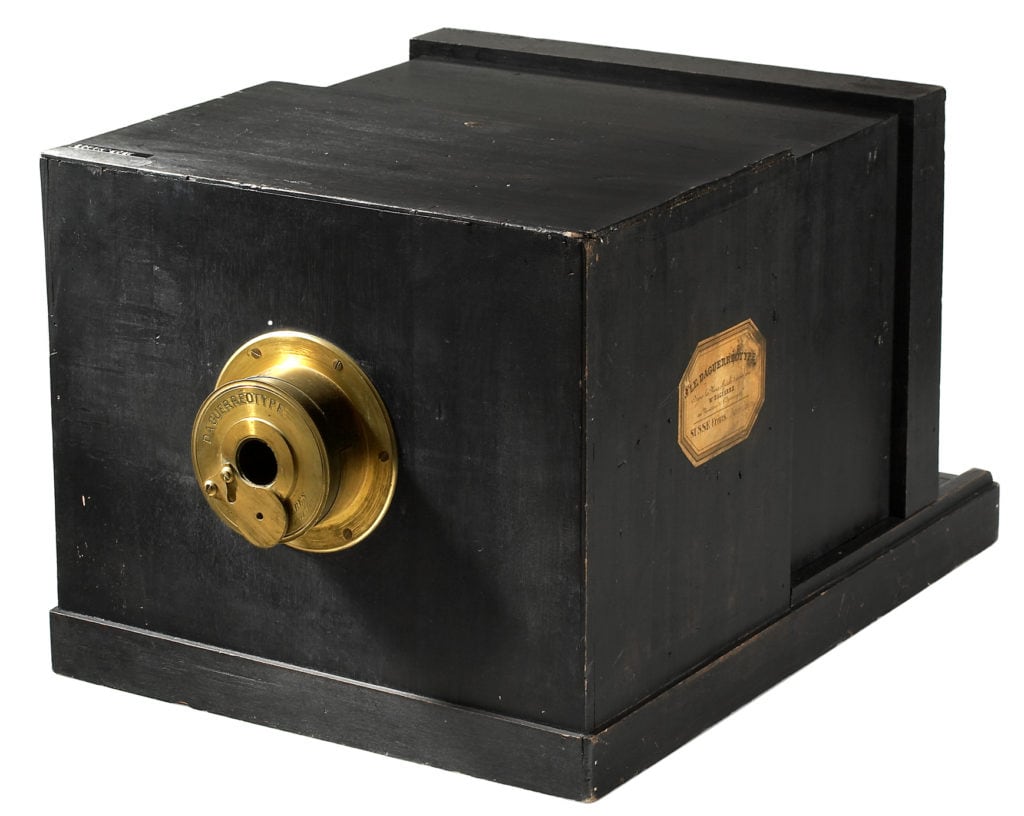
The first cameras were smaller versions of the camera obscura, a simple viewing device based on a sliding-box design that had been in use for several hundred years. By the 19th century this was commonly employed by landscape painters to achieve proper perspective. French artist Louis Daguerre built upon the work of Nicéphore Niépce, who had produced what is widely regarded as the first photograph in 1826, by designing the first camera to be commercially produced. This was the Daguerreotype, which was announced to the world in 1839.
Daguerreotypes followed the sliding-box design of the camera obscura, and used two boxes, one slightly smaller than the other. The lens was placed in the front box. The second, slightly smaller box, slid into the back of the larger box. Focus was achieved by sliding the rear box forward or backwards until the image was sharp on the ground glass focusing screen. The image was laterally reversed unless the camera was fitted with a mirror or prism to correct it. When the image was sharp the lens cap was put on the lens and the screen was replaced by a plate holder loaded with a sensitised plate to make an exposure. The lens cap was used as a shutter.
The daguerreotype used a direct-positive process, which created a unique and highly detailed positive image on a sheet of copper plated with a thin, highly polished coat of silver. The photographic process made use of a number of hazardous chemicals. Before sensitisation, the surface would be wiped with nitric acid to remove any organic matter. The plate was then sensitised by exposing the silver surface in darkness or under safelight first to iodine fumes, and then to bromine fumes, resulting in a silver halide coating. After exposure, the plate was carried to a developing box, where it was exposed to fumes from heated mercury. Finally, the plate was fixed by removing the remaining silver halide with a mild solution of sodium thiosulfate.
As there were no camera manufacturers at the time, Daguerreotypes were manufactured by opticians, cabinet makers and instrument makers.
Fox Talbot and The Paper Negative
A few years earlier, during the mid-1830s, the British gentleman scientist and polymath William Fox Talbot, had been keen to make a permanent record of what another draftsman’s aid, the camera lucida showed. The camera lucida’s purpose is to superimpose a refracted image of the landscape onto the artist’s sketchbook. It consists of an adjustable metal arm fastened at one end to the artist’s sketchbook and a glass prism at the other.
Talbot’s frustration with the camera lucida led him to recollect his previous experiences with the camera obscura and start to experiment to see if he could capture a permanent image to make nature record the image. He referred to these experiments as ‘photogenic drawing’.
Talbot found that a sheet of writing paper, coated with salt and brushed with a solution of silver nitrate, darkened in the sun, and that a second coating of salt impeded further darkening or fading. Talbot used this discovery to make tracings of botanical specimens. He would place the specimen on a piece of sensitized paper, cover it with a sheet of glass, and expose it to the sun. Wherever the light struck, the paper darkened, but wherever the plant blocked the light, it remained white. He called his new discovery “the art of photogenic drawing”, and it is still in use today in the salt print process.
Talbot’s salt print process evolved into the Calotype photographic process, where a sheet of paper coated with silver chloride was exposed to light in a camera obscura yielding a negative image. The image was “developed” on the paper, which was actually the acceleration of the silver chloride’s chemical reaction to the light it had been exposed to. The developing process permitted much shorter exposure times in the camera. The developed image on the paper was fixed with sodium hyposulfite. The negative could yield any number of positive images by contact printing on another piece of sensitized paper.
To minimise exposure times Talbot made use of much smaller cameras with short focal length lenses which would concentrate light on a smaller area. The best made lenses available to him were microscope lenses, which he fitted to small cameras his wife referred to as ‘mousetraps’ as he had so many of them around the house. It was with one of these small cameras, measuring only 2.5 inches each side that was used by Talbot to take his first successful photograph in 1839. Though the ‘mousetraps’ are the most well known Talbot made and commissioned many more sophisticated cameras during his research which are now distributed in museums throughout the world.
Similar Cameras, Different Images
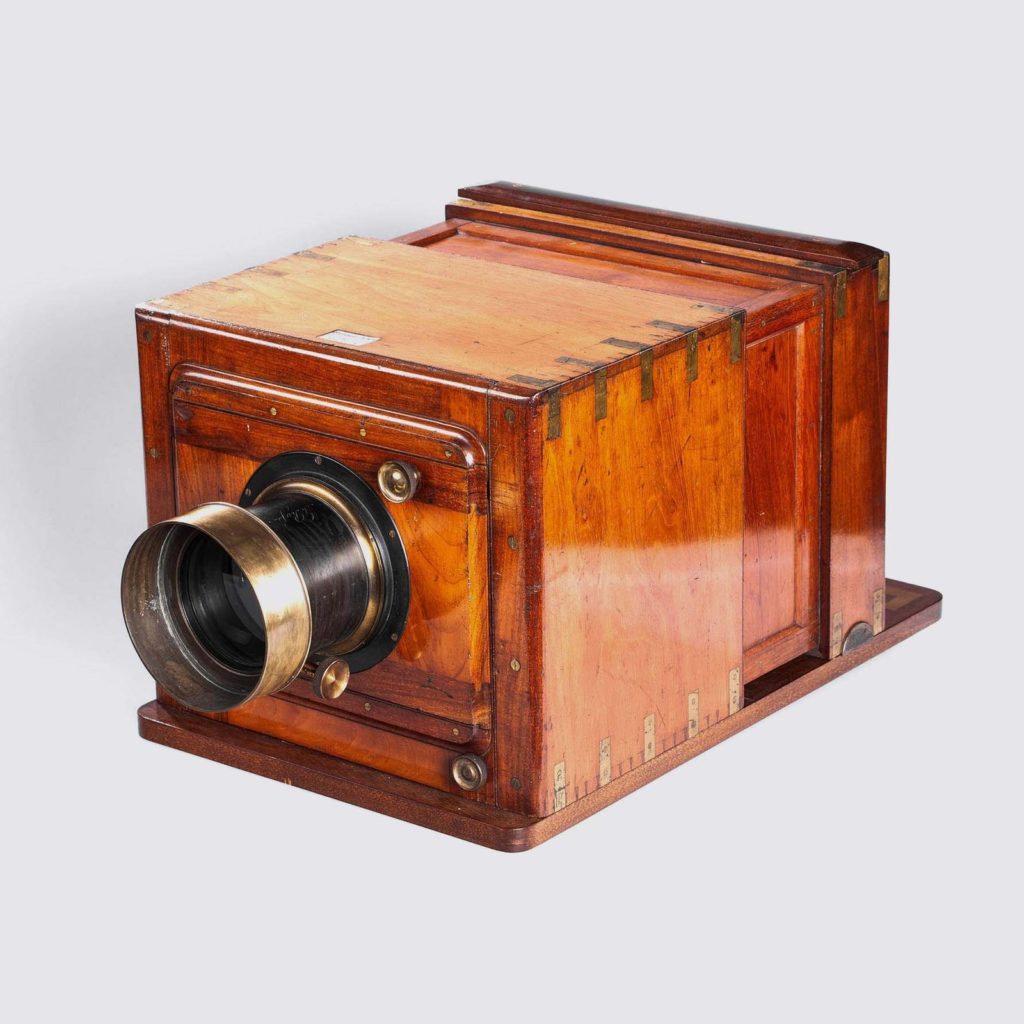
Creating a Calotype used much of the same basic equipment as found in Daguerreotype making. A similar camera type, though there were many variations for both methods, similar ways to expose the image and similar way of preparing, although the Calotype offered a somewhat safer process.
However, the difference between the images they produced was vast. While both created a monotone image, the Daguerreotype created pictures that recorded very fine details across the whole range of tones and appeared to produce a glow from within the image due to the reflective properties of the metal, which of course had no grain.
The Calotype images had higher contrast because the chemicals were absorbed into paper fibres, which reduced detail in the highs and lows. Because of those fibres, the image also offered a grain that would diffuse detail, rather than preserve it. As it was a paper to paper positive negative process, further detail would be lost in the transfer. This resulted in a less detailed but highly atmospheric image.
Cameras of the 1840s
Faster Lenses
The earliest daguerreotype exposure times ranged from three to fifteen minutes, making the process fairly impractical for portrait photography. This was due to the slow Chevalier lenses used by Daguerre. Accordingly, with few exceptions, daguerreotypes made before 1841 were of static subjects. Josef Max Petzval, a professor of mathematics at the University of Vienna, changed this with the design of a new lens, though it took nearly a year to design and manufacture it. It was the first lens to be designed using optical principles and mathematical computation – previously they had previously been ground and polished according to experience. In 1841 the first camera fitted with this lens was introduced by Voigtländer and Sons, an Austrian maker of telescopes and other optical equipment. It was the first portrait lens and had a 160mm focal length and an achievable aperture of f/3.6. Exposure times were many times shorter than with the previous generation of lenses.
Faster Exposures
In 1841 Franz Kratochwila freely published a chemical acceleration process in which the combined vapours of chlorine and bromine increased the sensitivity of the plate by five times, greatly reducing exposure times from minutes to between fifteen and thirty seconds in bright lighting conditions.
Early Camera Manufacturing
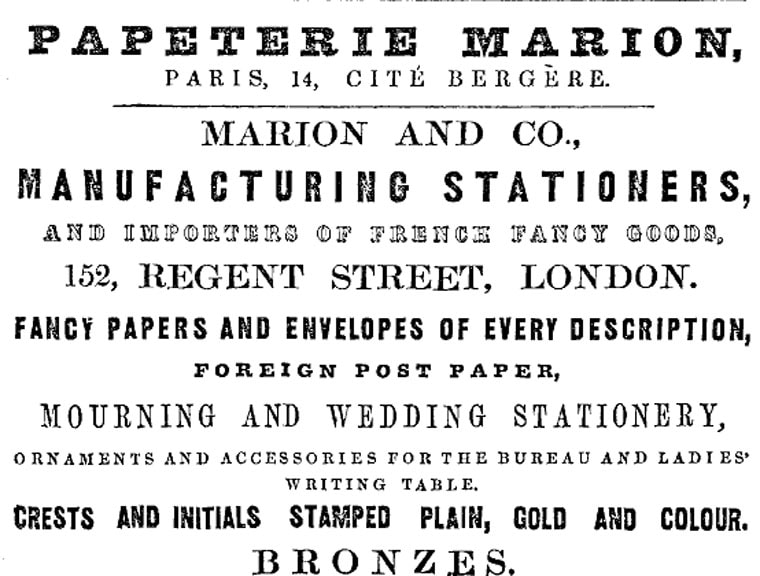
Gradually the opticians, cabinet makers and scientific instrument makers, as well as chemists familiar with the chemical process required for early photography evolved into photographic supply shops and camera manufacturers. French optician Noël Paymal Lerebours was one of the first, and used his skill in optics to manufacture and sell a sliding box whole-plate Daguerreotype camera, working from the instruction manual for Daguerre’s pioneering instrument. W. Butcher and Sons of London started as a pharmacy but evolved into a magic lantern supplier, then a camera importer and finally a manufacturer. George Hare was a joiner, like his father, before he started producing the high quality cameras he became renowned for in London. Frank Brownell, of Kodak Brownie fame, started as a cabinet maker in the 1880s. Another start point was stationery – Marion and Co Ltd, originally an offshoot of Auguste Marion of Paris, started in fancy stationery but widened their business to papers, prints, plates and then onto cameras.
These small firms were economically quite vulnerable. Thomas Ottewill, one of the leading British camera makers, was made bankrupt on several occasions during the 1860s. This was despite his claim in 1856 of ‘having now the largest manufactory in England for the making of cameras’ and having an incredible talent pool. Camera makers George Hare, T. Mason, Patrick Meagher, T. Garland and A. Routledge all worked for Ottewill before establishing their own businesses. Ottewill and brought in partners William Morgan and a Mr Collis after bankruptcy. A partnership arrangement offered greater protection for the business and this model was often adopted by the emerging photographic firms.
The 1850s
A Faster Chemistry Set
The wet plate collodion process of 1851 invented by Frederick Scott Archer was many times faster than previous methods and enabled photographers to make glass negatives combining the sharpness of a daguerreotype with the replicability of a calotype. However, wet plates needed to be processed wet which required photographers to carry around a portable darkroom as well as the camera.
A commercially viable method of producing a photographic print on paper from a negative was already available for wet plate collodion photographers in the form of the albumen print. This was published in January 1847 by Louis Désiré Blanquart-Evrard. Thin paper was coated with a layer of egg-white (albumen) containing salt and sensitized with a silver nitrate solution, then printed using daylight under a negative. The prints could be toned with a gold solution which gave a purple-brown tint to the image and reduced the risk of fading. This process would became the dominant form of photographic positives from the mid 1850s to the start of the 20th century.
The wet plate collodion process offered an alternative to the Albumen print in the form of glass-based positive made by taking an underexposed negative so that it could be viewed as a positive using a dark backing. This was known as the Ambrotype and was introduced in the early 1850s. The ambrotype quickly grew in popularity because it maintained the image clarity of the earlier daguerreotype —but was faster and cheaper to produce. The finished plate was usually mounted in a decorative presentation cases just as daguerreotypes had been. Also like the daguerreotype, which it replaced, each image was a unique original that could only be duplicated using a camera.
A second collodion-based positive emerged in the form of tintype, or ferrotype, which replaced the Ambrotype’s glass plate with a thin sheet of japanned iron. The process was first described by Adolphe-Alexandre Martin in France in 1853. This type of photography survived well into the twentieth century because of its continued use by street photographers.
Bellows
In the late 1850s sliding-box gave way to a leather bellows with a lens plate at one end, and the light-sensitive plate holder at the other. First came a square design and then a more compact tapering version. In 1856 Captain Francis Fowke patented a compact concertina-pattern pleated bellows camera of his own design, which was the first to use cloth bellows, rather than a wooden body between the lens and plate. The tapering design invented the following year by C.G.H. Kinnear, and proved extremely durable. It is still in use in large format cameras today.
The 1860s
First Steps Towards Industrialisation
By the 1860s the medium had started to become industrialized. Instead of mixing chemicals according to their own recipes and hand coating their papers, photographers could buy commercially prepared albumen papers and other ready made supplies. The market was moving increasingly towards the middle-class, which required photographers to produce a greater quantity of cheaper prints. In this new market, the photographers original artisan processes and refined techniques became less important.
The quest for a larger volume of prints gave rise to the he carte de visite (CdV) which was patented by André Adolphe Eugène Disdéri in 1854. His camera featured a moveable chassis and multiple lenses, with which he could make eight exposures on a single glass-plate negative, print the entire plate at once, cut the sheet into eighths, and paste the individual photographs on mounts the size of visiting cards. The carte de visite was slow to gain adoption until 1859, when Disdéri produced CdVs of Emperor Napoleon III’s which caused a sensation a triggered a craze that would last throughout the 1860s as ‘cardomania’ until it was supplanted by the larger ‘cabinet card’ of the 1870s.
The cameras that took multiple images at once were known as “Multiplying Cameras.” The number of lenses varied with some cameras having 4 lenses others 8, 9, 15 or a few a even 36 lenses, but regardless of the number of lenses the multiple images were exactly the same.
The Fast(er) Distortion Free Lens
By 1865 photographers had three types of lenses available to them: the simple landscape meniscus, the Petzval Portrait lens, and the wide-angle Globe lens or the Ross Doublet. What they needed was an intermediate lens with minimal distortion. The Rapid Rectilinear lens which fulfilled this requirements was introduced by J. H. Dallmeyer in 1866. Most previous rectilinear (i.e., distortion less) lenses had been slow (f16), and Dallmeyer was therefore justified in calling his f8 lens rapid. Lenses of this type were fitted to most better quality cameras for nearly sixty years.
The 1870s
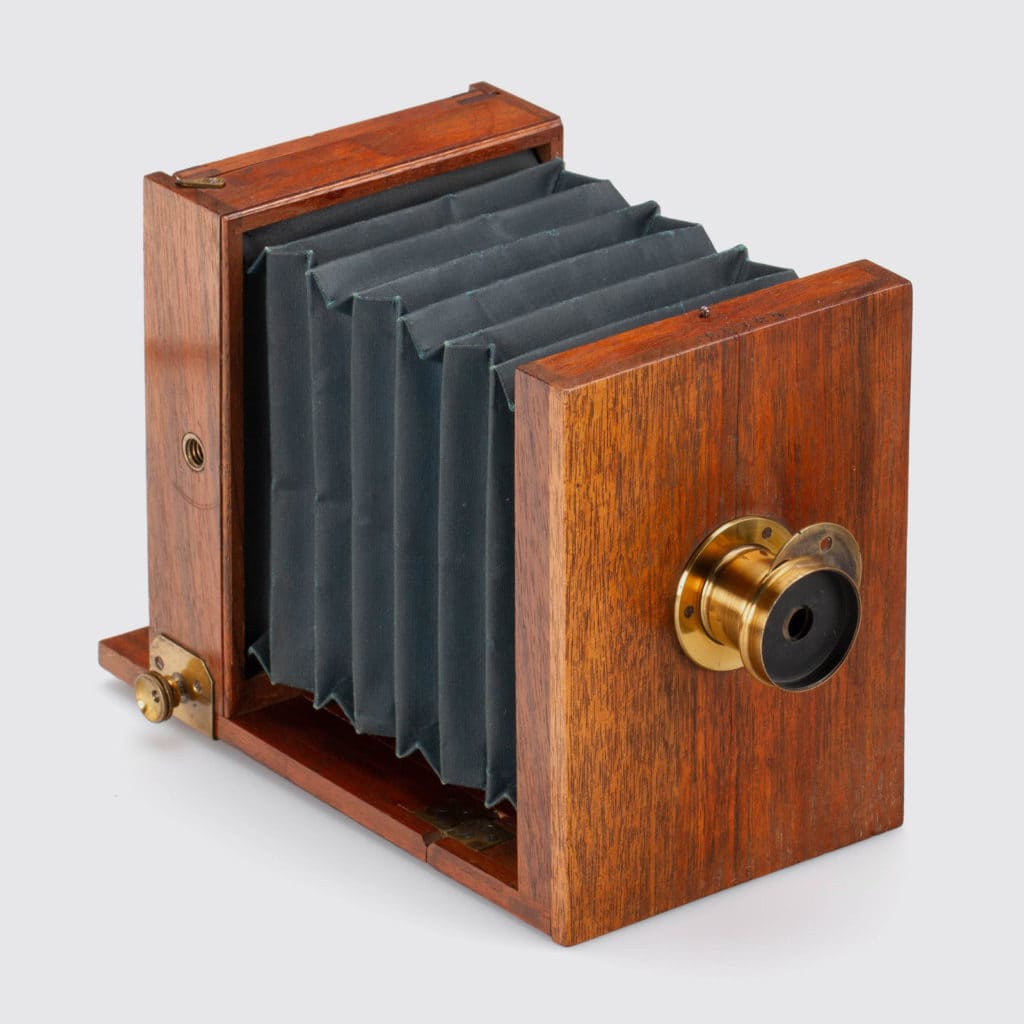
The Tailboard Camera
The tailboard camera gradually became more popular – a camera with bellows and rear focusing. Focusing with a tailboard camera is carried out by adjusting the ground glass back’s position forward or backward until the image on the matte screen is sharp. The design goes back to the 1850s but adoption accelerated in the 1860s. A good example is the Hare Tailboard of 1878. Tailboard cameras were still available into the 1890s and 20th century, as typified by the Ernemann Alex shown left.
The End of the Portable Chemistry Set
Dry plates, glass plate coated with a gelatin emulsion of silver bromide, superseded wet plates in the 1870’s. These could be stored until exposure, and after exposure could be brought back to a darkroom for development at leisure. This was far more convenient than the wet collodion process, which required the plate to be prepared just before exposure and developed immediately after. The dry plate could be factory produced. It was still important to have a camera which could fold down to increase portability size even though the photographer no longer required a portable darkroom.
The 1880s
Hand and Detective Cameras
In the 1880s the hand camera, also known early on as the ‘detective camera’ was introduced. The terms ‘detective’ and ‘hand’ camera were used interchangeably during the 1880s. The Oxford English Dictionary records the former term in the British Journal of Photography in 1881 and the latter term in the Photographic News in 1889 and meaning a hand camera adapted for taking instantaneous photographs. Compared to larger bellows cameras, the design was unobtrusive. Many manufacturers introduced their own designs, including Rouch with the Eureka and Fallowfield with the Facile. The Eureka’s back incorporated a built in changing bag so that the photographer could move an exposed plate and insert an unexposed on ready for his next shot without the need for separate plate holders.
Modern Bellows
The 1880s also saw an evolution of the bellows design with George Hare’s New Patent Camera of 1882, a front focusing model which built on the Kinnear design with a back hinged to the baseboard and a front which pulled out on rails for focusing. The British Journal of photography described the camera as ‘the model upon which nearly all others in the market are based’ – despite Hare’s patent.
The Quest for Flexible, Lightweight Media: Celluloid Plates
A number of photographers experimented with celluloid as a replacement for their heavy and fragile glass plates. John Carbutt, an English photographer who had emigrated to America, was the first to gain some success. He persuaded the Celluloid Manufacturing Co. to produce a thin celluloid film which was sufficiently transparent for photographic purposes around 1884 and started to manufacture cut film using this material in 1888, but it was slow to catch on.
Paper and The Roll Film Holder
In 1883, George Eastman startled the trade with the announcement of film in rolls, with the roll holder adaptable to nearly every plate Camera on the market. His first approach was to coat the photographic emulsion on paper and then load the paper in a roll holder. The holder was used in view cameras in place of the holders for glass plates.
Flexible, Lightweight Roll Film
Eastman was well aware, however, of the serious drawbacks associated with using paper as a photographic support and began experimenting to find a flexible, transparent base from about 1884 onwards. It was not until early in 1888, however, that he began seriously considering celluloid as a possible medium. He set a young research chemist, Henry Reichenbach, to work on the problem, which Reichenbach duly found. The first successful roll-film hand camera, The Kodak, was launched publicly in the summer of 1888, followed by an improved model in 1889. This second Kodak was the Kodak No 1 and featured an easily removable lens board, and an improved shutter.
Independently, the Rev. Hannibal Goodwin had also devised a process for making celluloid film and applied for a patent in 1887. However, due to an unclear patent submission (Goodwin was not a chemist), the patent was not granted until 1898. By this time George Eastman had started production of rollfilm using his own process. It was not until after Goodwin’s death that it was ruled that Kodak had infringed Goodwin’s patent.
Roll Film Processing
Although the Kodak was made possible by technical advances in the development of roll film and small, simple cameras, Eastman’s real genius lay in his marketing strategy. By simplifying the operation of the camera and the processing the film for the consumer, he made photography accessible to the casual amateur, coining the memorable slogan: “You press the button, we do the rest.”
The 1890s
The 1890s Camera – Greater Variety, Faster Shutters and Easier to Use
The 1880s saw a number of significant developments, but in the 1890s this accelerated with faster shutters, daylight loading film, packaged dry ferrotype plates, camera movements, folding cameras and pocket cameras all appearing in that decade.
The Dry Plate Tintype
The dry plate process came to tintype or ferrotype photography with the manufacture of the gelatin tintype in the 1890s. This was followed by the introduction of packaged dry ferrotype plates the following year. This was popularly adopted and was popular into the the 1920s when the widespread use of the roll film camera by the amateur photographer greatly reduced the need for street, country fair and beach vendors.
The First Fast Shutter
In the 1890’s the first fast shutter appeared, patented by Ottomar Anschütz in 1888 in Germany and 1889 in Britain. It was capable of exposures as short as 1/1000 of a second, which at the time was considerably faster than other shutter designs. It was incorporated into the Goerz Anschütz camera, including a collapsible version, which proved both popular and durable. This fast, portable camera made the medium capable of capturing activities such as cycling races, rowing and other sports. These were featured in illustrated periodicals and newspapers that started to incorporate photographs during the 1890s.
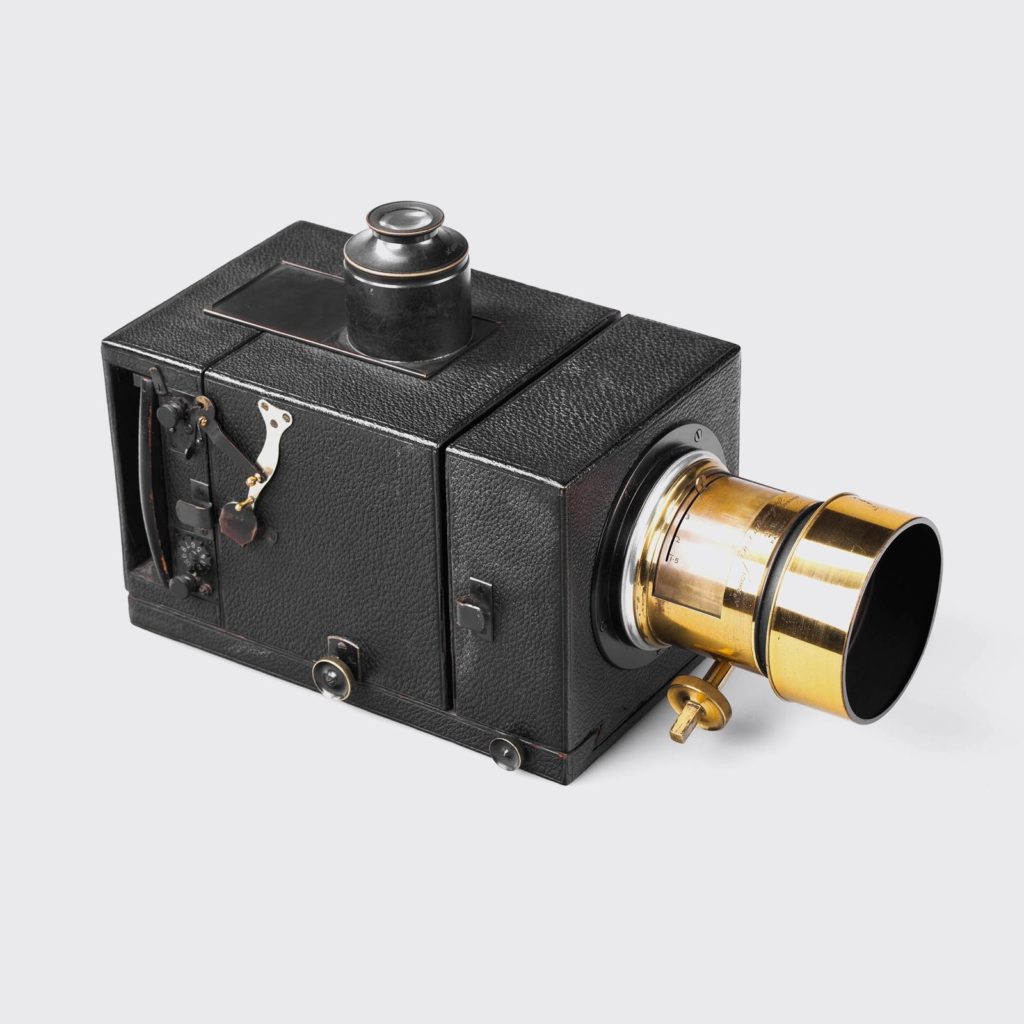
Daylight Loading Film
The 1890s also saw the introduction of daylight loading. Kodak introduced its first daylight-loading camera, the Daylight Kodak, in 1891 which meant that the photographer could now reload the camera without using a darkroom. Film for the Daylight Kodak had a black paper trailer at the beginning and end of the film which covered it during loading and unloading.
Camera Movements
In 1895 Fredrick H. Sanderson patented a mechanism for swinging the front lens panel, resulting in Sanderson’s Universal Swing Front Camera. This was a bellows camera with a variably movable lensboard and the first highly flexible view camera which introduced large format camera movements which include include rise and fall, lens shift, swing and tilt, and are still in use today. The field camera, a term suggestive of portability compared to heavier studio cameras, was one of several types of cameras available in the late nineteenth century including hand and stand and reflex models. There were as yet no rangefinder cameras, which would not be introduced until 1916 with the Kodak 3A Autographic Special.
The Pocket Camera and the Snapshot
In 1895 The Pocket Kodak was introduced, which was the first mass-produced snapshot camera. The Pocket Kodak was one of the first cameras that use front roll design, daylight film spools and a red window to see the number of the exposure on the back of the film. In a front roll design the feed and take up film spools are located in the front of camera, where there is enough room to the left and right of the incoming light rays. Before this design was introduced, the spools were located behind the plane of focus, making the camera about one third longer.
This small compact camera was also was easy to use: “one button does it” was the Kodak slogan. Photography was no longer restricted anymore by heavy equipment supported by with tripods and casual amateur photography, characterised by the snapshot was born. The term snapshot was coined earlier, in 1860, by Sir John Herschel, based on the hunter’s term for a quick shot made without careful aim, although it took until the 1890s to be matched to a technology. The associated term ‘snapshotter’ was noted by The Oxford English Dictionary from 1899, ‘snap-shottist’ from 1891 with the term ‘snap-shot’ from 1894.
Folding Cameras
The Folding Pocket Kodak of 1897, was a significant milestone in camera development as it was to establish the principals of the folding roll film format, which would continue to dominate camera design from the 1890s to 1930s. This design offered the photographer a camera that would fold up into a compact package that was light and easy to carry via a lens standard panel that pulled out on sprung struts with collapsible bellows. A classic example is the Kodak No. 2 Folding Autographic Brownie which is reviewed on this site.
The Turn of the Century
The Rise of Personal Photography
By the early 1900s Kodak had introduced the first of the Brownie series which brought the snapshot to the masses in the form of an affordable cardboard box camera that took pictures on roll film.
Timeline of Early Cameras
- c. 1826 Joseph Nicéphore Niépce uses bitumen of Judea for photographs on metal and makes the first successful camera photograph, View From My Window at Gras
- 1827 Niépce addresses a memorandum on his invention to the Royal Society in London, but does not disclose details
- 1829 Unable to reduce the very long exposure times of his experiments, Niépce enters into a partnership with Louis-Jacques-Mandé Daguerre
- Charles Chevalier creates a compound achromatic lens to cut down on chromatic aberration, a failure of a lens to focus all colours to the same plane, for Louis-Jacques-Mandé Daguerre’s photographic experiments
- 1832 Robert Hunt’s Researches on Light records the first known description employing platinum to make a photographic print, but does not succeed in producing a permanent image
- 1835 William Henry Fox Talbot makes his first successful camera photograph or “photogenic drawing” using paper sensitised with silver chloride.
- 1839 The public birthday of photography, from three inventors – Daguerre, Fox Talbot and Bayard
- Susse Frères manufactures a daguerreotype camera which is one of the first two photographic cameras ever sold to the public
- The first camera to be manufactured in any quantity is the Giroux Daguerreotype
- c. 1840 The Voigtländer Daguerreotype is the first camera made of metal. It is the fastest camera lens of its time, with an aperture of f3.6
- 1840 French optician and daguerreotypist Noël Paymal Lerebours uses his skill in optics to manufacture and sell a sliding box whole-plate camera, copied from the instruction manual for Daguerre’s pioneering instrument
- Alexander Wolcott patents the daguerreotype reflector camera which uses a concave mirror to focus the available light onto a photosensitive plate
- 1841 Charles Chevalier creates a double-box camera that uses a half-sized plate
- William Henry Fox Talbot patents the calotype, or paper negative process
- The Nouvel Appareil Gaudin camera uses a metal disc with three differently-sized holes mounted on the front of the lens to provide variable f-stops
- 1843 Joseph Puchberger patents the first hand crank driven swing lens panoramic camera
- Two French Physicists, Fizeau and Foucault develop the first recognisable shutter mechanism in order to photograph the sun
- 1845 The Bourquin of Paris camera is the first camera with the lens in a metal tube using a rack and pinion mechanism for focusing
- 1849 David Brewster develops the lenticular Brewster Stereoscope.
- 1851 English sculptor Frederick Scott Archer invents the Collodion process, or collodion wet plate process, which is 20 times faster than all previous methods and is free from patent restrictions
- The Great Exhibition transforms stereoscopy from a minor scientific interest to a craze which will not wane until the 1870s
- 1851 W. and W.H. Lewis introduces the first commercially produced bellows camera in the US, the Lewis-type daguerreotype
- 1853 Thomas Ottewill and Company registers a double folding sliding camera
- The Tintype process is first described by Adolphe-Alexandre Martin – an inexpensive direct positive on a thin sheet of metal coated with a dark lacquer or enamel
- 1854 Andre Adolphe Disderi is the first to devise a way to make multiple Carte de Visite images on a single photographic plate, which requires a new type of camera with a shifting back. Each time the back is moved, a different portion of the plate is exposed allowing a set of several images to be printed at the same time. These cameras soon become known as Multiplying Cameras
- James Ambrose Cutting takes out several patents relating to the Ambrotype process, underexposed or bleached wet collodion negatives that appeared positive when placed against a dark coating or backing
- 1856 Captain Francis Fowke patents a compact concertina-pattern pleated bellows camera of his own design. It is the first to use cloth bellows, rather than a wooden body between the lens and plate. It will be produced the following year by Ottewill & Co. for the British Government
- 1857 The folding camera with tapering bellows is invented by C.G.H. Kinnear, forming the basis for subsequent bellows designs
- David Acheson Woodward patents the solar camera, derived from the earlier solar microscope, using sunlight to make enlargements from glass negatives
- c. 1857 Horne & Thornthwaite produces a sliding box wet-plate camera featuring a sliding box movement and a rack and pinion lens movement
- 1858 John Waterhouse invents Waterhouse stops, a system using plates with different aperture diameters that could be inserted into a slot in the lens barrel which are the earliest selectable stops
- 1859 The Excelsior Wet Plate Camera is invented by August Semmendinger, one of the first US manufacturers of wet plate photography equipment.
- 1860 P. Meagher introduces an improved version of the Kinnear design called the Improved Portable
- 1861 The first photographic single-lens reflex camera (SLR) is invented by Thomas Sutton
- James Clerk Maxwell’s colour experiment demonstrates the basis of colour imaging.
- 1862 The Pantoscopic camera is produced by Johnson and Harrison in England. It is one of the first designed to take panoramic photographs (110º view) on glass plates. It produces 7½ x 12 inch images on flat collodion plates
- 1864 The Dubroni No. 1 is the first successful self-developing camera
- 1873 Charles Harper Bennett improves the gelatin silver process by hardening the emulsion, making it more resistant to friction
- 1866 The Rapid Rectilinear lens is introduced by John Henry Dallmeyer, reducing distortion, coma and lateral colour
- 1874 The Scénograph, an early collapsible strut camera ideal for use in the field, is designed by Dr. Condèze of Belgium
- 1878 G. Hare introduces an Improved Portable Bellows Camera, with bellows and rear focusing. It is focused by adjusting the ground glass back‘s position forward or backward until the image on the matte screen is sharp, an approach which characterises the tailboard camera
- 1878 Heat ripening of gelatin emulsions is discovered by Charles Harper Bennett, making possible very short exposures and paving the way for the snapshot
- W.W. Rouch & Co. produces the Patent Portable, a light weight bellows camera which takes 6 ½” x 8 ½” plates held in slides
- 1879 The Lancaster’s Gem Camera (Carte Apparatus) is manufactured by J. Lancaster & Son. Gem cameras produce multiple small images, although there is no standard size for ‘gem’ images.
- c. 1880 The Photographic Artists’ Co-operative Supply Association introduces the PACSA tailboard camera
- 1881 Thomas Bolas patents a hand-held, box form camera he calls a detective camera
- 1882 Etienne Jules Marey perfects a chronophotographic gun, a device capable of taking 12 exposures a second and capturing motion sequences.
- G. Hare introduces the influential New Patent Camera or ‘1882’ pattern with a back hinged to the baseboard and a front which pulled out on rails for focusing
- c. 1882 Transitional wet-plate cameras, which can take both wet and dry-plate slides are sold by companies such as J.H. Dallmeyer
- 1883 Ottomar Anschütz designs a camera with an internal roller blind shutter mechanism in front of the photographic plate – the first focal-plane shutter in recognisable form
- William Schmid patents the first detective camera to be widely sold
- 1884 The first production SLR with a brand name is Calvin Rae Smith’s Monocular Duplex
- The McKellen Treble Patent marks the boundary between the older Kinnear pattern and the newer field camera design that will remain popular to the end of the Edwardian period
- 1885 The London Stereoscopic Co.’s Carlton may be the first off-the-shelf twin-lens reflex TLR camera, providing continuous reflex viewing through a second lens.
- The Waterbury View Camera is offered by the Scovill Manufacturing Company. Its is a light and compact popular camera that becomes available in numerous sizes from 4 x 5 to 8 x 10 inches
- 1886 The first single use camera, the Ready Fotografer, is introduced, using a dry plate, though it appears to have enjoyed very limited success
- Thornton-Pickard Manufacturing Co. introduces the Jubilee in readiness for Queen Victoria’s Golden Jubilee incorporating a rotating lens panel able to hold up to four lenses
- C.P. Stirn patents the Stirn Concealed Vest Camera (or waistcoat camera in the UK) which becomes a popular and much copied design
- George Eastman and Franklin M. Cossitt patent the Eastman Detective Camera. Though it is not successful, it is a precursor of the hand-held Kodak of 1888
- c. 1886 J. Lancaster & Son Introduces The International patent tailboard mahogany half-plate camera
- c. 1887 The Mayfield Pocket Camera from Mayfield, Cobb & Co. Ltd is one of the first cameras to be made of a plastic-like substance such as ebonite
- 1887 E. Français introduces the Kinegraphe Grand Angle, one of the first twin-lens reflex cameras
- Marion & Co. introduces the New Academy which adds a mirror behind a glass screen to a pair of vertically mounted lenses which slide for focusing making the camera into a twin-lens reflex model
- The Interchangeable View Camera is marketed by Eastman Dry Plate & Film Co. It is a plate camera that can also be fitted with an Eastman Roll Holder containing a roll of flexible film
- 1888 The Kodak is George Eastman’s legendary first roll-film camera bearing the new brand name. It comes pre-loaded with a 100-exposure roll of flexible film. After finishing the roll, the consumer posts the camera back to the factory to have the prints made
- ‘Krügener’s Taschenbuch’ Patent Book Camera is one of the smallest cameras of its time, with dimensions of just 45 × 100 × 140mm
- E & H T Anthony introduces the Fairy, an 8 x 10 inch lightweight folding view camera with a revolving back and bellows so pictures could be taken both horizontally or vertically
- 1889 The No.1 and No. 2 Kodaks are introduced. They resemble the original Kodak Camera, but have a different shutter and are available with paper-based stripping film or its successor, Eastman transparent film
- George Eastman introduces the first transparent plastic roll film, made from highly flammable cellulose nitrate film
- The Loman Reflex, the first commercially produced camera with a focal-plane shutter, is introduced
- c. 1890 L’Orthoscope by E. Tourtin, is the first French reflex camera, for plates 9 x 12cm
- 1891 Kodak markets its first daylight-loading camera, the Daylight Kodak, which meant that the photographer could now reload the camera without using a darkroom.
- 1892 The Boston Camera mfg. Company produces the Bulls-Eye camera, the first to use Samuel Taylor’s new numbered paper backed film, which requires the introduction of a red window
- W. Griffiths & Co. Ltd introduces the innovative Zodiac which replaces the usual wooden base of the period with telescoping metal tubes. The rear standard slides along the tubes and for fine focusing they are extended by a worm screw
- 1893 J. Lancaster & Son, Birmingham, England introduces the Instantograph Patent Camera, a 1/4-plate model complete with Lancaster’s Patent Instantaneous Lens and rubber-band shutter, one of a series of models first introduced in 1888
- The first Richard Vérascope stereo camera is launched. It is the best selling stereo camera of its time. The range will continuing through the 1950s
- 1894 Kodak markets the Flat Folding Kodak in England. It is a folding camera for darkroom loaded roll film, with a capacity of 48 pictures of 4 x 5 inch on one spool
- The Xit series of cameras are introduced by J. F. Shew. The folding side-strut design (also known as chambre à joues) makes the camera quite compact when folded. Shew advertises them as “the most portable camera in the world”
- 1895 The Pocket Kodak appears, the first mass-produced snapshot camera
- Sanderson’s Universal Swing Front Camera is introduced, a bellows camera with a variably movable lensboard and the first highly flexible view camera
- The Briefmarken Camera was manufactured by Emil Wunsche, of Dresden Germany featuring 12 lenses to capture 12 stamp size portraits simultaneously on 9 x 12cm size plates
- 1896 The Zar Camera Company of Chicago launches the Pocket Zar, a miniature glass plate box camera with a body entirely constructed of cardboard, a material never used to such an extent in cameras before
- 1897 Kodak markets the Folding Pocket Kodak, which produces a 2¼ x 3¼ inch negative
- Kodak introduces the No. 4 Cartridge Kodak, which takes 4 x 5 daylight loading roll film and becomes the most successful of the range with more than 90,000 produced between 1897 to 1907
- 1898 The ‘Al-Vista’ panoramic camera is produced by Multiscope & Film Co, Burlington, USA
- c. 1899 The Pascal is one of the first cameras for roll film, and the first with spring-motorised film advance. It is a box camera, with a wood-and-metal body, with leather covering and makes twelve pictures 40×55 mm on special roll film
- 1900 Kodak introduces the first of the Brownie series which brings the snapshot to the masses. It is a cardboard box camera with a simple meniscus lens that takes 2 1/4-inch square pictures on 117 roll film
- Kodak markets the The No. 3 Folding Pocket Kodak Camera, a camera that would go on to have probably the largest number of model variations of any Kodak camera made.
Early Photography Web Resources
Most of the resources I have found for early photography provide information on British manufacturer’s and their cameras. This is not because that is my exclusive interest, jut what I have come across so far. If you have information on early photography books or websites from Germany, France, the US or any other country, please share them with me and I’d be glad to update this article.
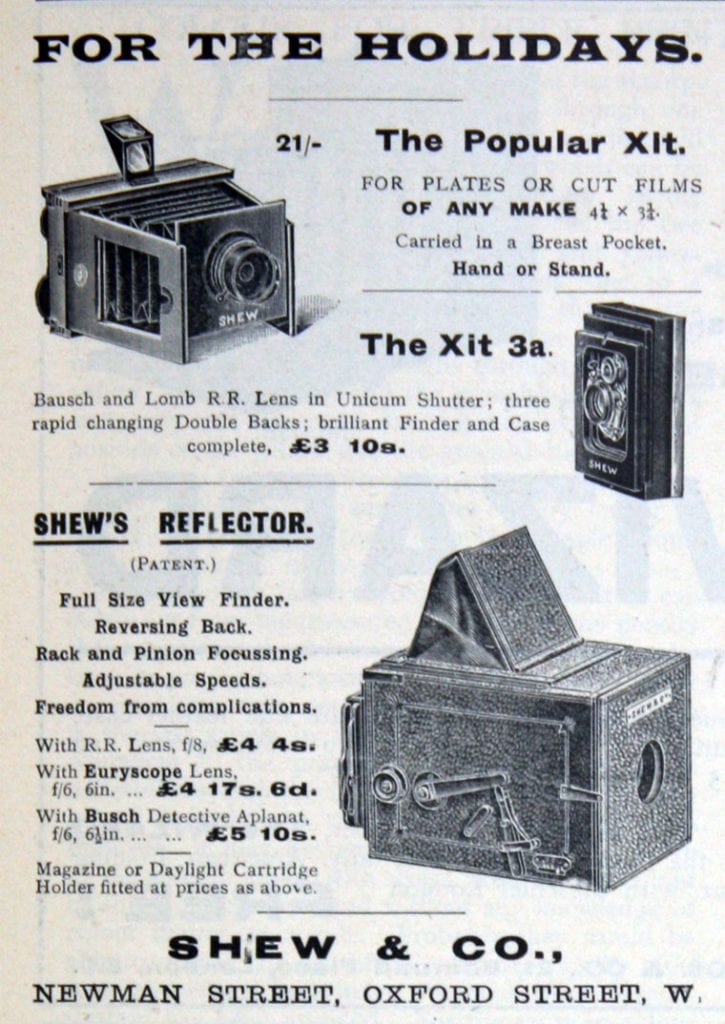
- There are two more articles on early photography on this site: Fox Talbot and Early Photography and Alcohol, Ether and Gun Cotton, which describes the wet-plate collodion process.
- There is an article on the Kodak No 2 Folding Autographic Brownie (1915-1926) on this site.
- Graces Guide to British Industrial History – Photography. Provides valuable information on early photography, particularly manufacturers.
- Coeln Cameras Historical Cameras (1840-1940). Peter Coeln’s superb site offers museum quality early cameras for sale
- A research paper on the early camera manufacturers by Michael Pritchard The Development and Growth of British Photographic Manufacturing and Retailing 1839-1914 by Michael Pritchard (pdf)
Books on Early Photography
- British Camera Makers. This fine book by Norman Channing and Mike Dunn, now out of print, but still available second hand, covers early photography in Britain in detail, extending into the twlighlight of manufacturing in Britain in the 1960s.
- A History of Photography in 50 Cameras by Michael Pritchard is one of the best books on cameras I have read and covers some of the most important camera models, including some early cameras
- The massive Encyclopedia of Nineteenth-Century Photography appears to be the definitive work on early photography up to the beginning of the twentieth century, with 1,200 essays. It is however, extremely expensive to purchase in print – I’ve read a couple of the essays online but have not purchased it.
I hope you enjoyed this article on cameras through the years and accompanying timeline. If you spot omissions or errors, please let me know in the comments.

